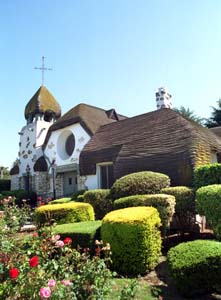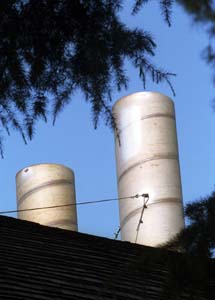![[Metroactive News&Issues]](http://metroactive.com/gifs/news468.gif)
[ San Jose | Metroactive Central | Archives ]
Photograph by George Sakkestad
Pulling Teeth
In mercury-laden Silicon Valley, environmentalists say extreme toxicity calls for extreme measures--even if it means making crematories remove the filled teeth of the dead.
By Mary Spicuzza
Dealing with the remains of dearly departed loved ones is never easy. Bereavement aside, decisions loom about whether to opt for open or closed casket and burial or cremation, and what to do with the ashes. Now local environmentalists argue that those opting for cremation need to start asking yet another question: What should be done with the teeth of the deceased?
Conservationists working to reduce mercury contamination in the Bay Area say that mercury-laden dental fillings, which go up in
smoke during cremation, are creeping into the environment at alarming levels.
"There are a lot of questions about air emissions from crematoria, but we definitely believe that it's a significant source of mercury contamination," says Cori Traub, project director for San Francisco-based Clean Water Action. "It's a gruesome thing to think about, but it's something we should control, and can control."
Traub and other ecologically minded members of the pollution prevention workgroup of the Mercury Council, which includes representatives of the Silicon Valley Toxics Coalition, want to take action to reduce all emissions of mercury, whether through air or water or from old thermometers. Working with the San Francisco Regional Water Quality Control Board, they also hope to reduce the amount of mercury that ultimately washes into the bay, from streams, runoff and even from particles in the air which enter the water supply via acid rain. Only preliminary studies have been completed, with more to follow over the next few months, but the environmental community believes the crematories are the third highest contributor to modern air emissions of mercury in the region, according to a 1999 Public Works Department memorandum.
The proposed solution favored by activists is to pull the teeth of the deceased before cremation.
But Randy Krassow, president of Santa Cruz Memorial Park, says that while some see pulling teeth as a quick fix, it would be far more complicated in practice.
"I can't imagine how it would be easy. I've had teeth pulled before and it wasn't easy," Krassow says. "But it would be time-consuming and expensive to start drilling mercury out of teeth. And I'd be thinking about how the families would feel about this."
Krassow says that few dentists are trained in forensic dentistry, and adds that most bodies treated by his Santa Cruz crematorium already have dentures anyway.
Neptune's Kingdom
THE COURTYARD of the downtown San Jose office for the Neptune Society of Central California office breathes serenity. Cars frantically speed past its Second Street facade, but a meditative calm rules inside Neptune's massive iron gates. Tile-lined fountains trickle into a koi pond dotted with lily pads, where vibrant orange fish nibble algae from the bottom.
But fish, symbols of life for some, are also living reminders of potentially deadly mercury levels that remain in the watershed of the Santa Clara Valley. Mercury tailings left over from quicksilver mining conducted here for 150 years remain in stream beds and lakes and parts of southern San Francisco Bay, where fish still consume it. Santa Clara County is home to the
Members of the Mercury Council acknowledge the importance of cleaning up old mercury and stress that, because of the high toxic levels already here, it is all the more important to eliminate new sources. Yet there are an estimated 365 kilograms pumped into the air each year, according to the work group's draft reports.
Cement manufacturing plants--such as Hanson Cement Corporation (formerly Kaiser) on Stevens Creek Boulevard--as well as Tosco Corporation refineries top the list of those emitting mercury into the air. But the third-largest source seems to be rooted to peaceful spots like the Neptune Society--and any other company that sends bodies into crematories with fillings intact.
"Air release of mercury must be eliminated," Michael Stanley-Jones, senior researcher for Silicon Valley Toxics Coalition, writes in the spring 2000 issue of the group's newsletter. "Crematoriums will have to cease incinerating dental amalgam." Dental amalgam, the stuff used to fill cavities in teeth, is 56 percent mercury.
Like Traub, Stanley-Jones is a member of the pollution prevention workgroup. Last August the group released a draft study of mercury sources indicating that crematories contribute more than 14 percent of airborne mercury in the region, based on public works statistics.
"There are lots of different options for reducing emissions, but for crematoriums it's just don't burn the fillings. It's an obvious target," Clean Water Action's Traub says.
For the next three months her organization will be researching crematories' emissions as only one part of a massive study on mercury contamination in the bay. She believes mercury is becoming the next major toxics issue, comparable to lead, and argues that a strong neurotoxin that is especially dangerous to children should have much tighter regulations. Reports may be preliminary, but environmentalists are already looking at crematoriums to pull teeth before burning bodies.
Traub says matter-of-factly, "It's a low-hanging fruit in immediately reducing mercury air emissions."
THE TROUBLE WITH mercury, besides being a potent neurotoxin, is the way it bioaccumulates, building up in dangerous ways for both fish and humans. More than 1 million pounds of mercury lines Santa Clara County's rivers and streams. Contaminated fish eaten by humans can have toxic effects, especially in young children and pregnant mothers. This month, Clean Water Action released a study called In Harm's Way, detailing the effects of exposure to mercury, which attacks the nervous system and has been linked to developmental disabilities. The group also suggests mercury may be responsible for some cases of attention deficit disorder.
The concern about crematories comes at a time when environmentalists are already frustrated with California's water pollution and mercury management policies. On May 30, Waterkeepers Northern California and other bay advocacy groups filed a lawsuit charging that the state's new regulations governing pollution of lakes and rivers are much too lax. The suit, filed last Tuesday with the state Supreme Court, argues that the rules will "perpetuate the contamination of California's rivers, lakes, bays and estuaries" with substances like mercury and dioxin. Then, at a May 26 pollution prevention meeting, held to discuss the Regional Water Quality Control Board's management of mercury in San Francisco Bay, members concluded that sources of airborne mercury should be specifically addressed, according to meeting minutes.
The connection between Silicon Valley crematories and the San Francisco Bay may seem convoluted, but once a toxin like mercury is released in the air it can return in the form of acid rain and eventually run off into waterways. It's not always easy to trace the mechanics of airborne mercury contamination, which water board members believe is responsible for 10 percent of the mercury found in the bay.
"There's a big difference between air emissions and deposition," Lisa Vasano of the Environmental Protection Agency says. "Not all emissions are deposited to the bay. Some end up on the land, and only a portion makes it into the bay. The big concern is mercury getting into the water system."
Officials from the Bay Area Air Quality Control Board acknowledge that crematories release mercury into the environment. But Terry Hemeyer, a spokesperson for Service Corporation International, which owns San Jose's Oak Hill Memorial Park and Funeral Home, which has two crematories on site, says the facilities are already closely watched by government agencies.
"It is very highly regulated by Bay Area Air Quality Management District," Hemeyer says.
When asked specifically about environmentalists taking issue with mercury air emissions, he says he hasn't spoken with any of them.
"This is the first I've heard of it," he replies.
Ashes to Ashes
LOOKING OUT OVER the beautiful Oak Hill grounds reveals why air emissions from crematories is such a sensitive subject. Dotted with colorful flowers and beautiful statues, Oak Hill creates a sacred space for families to come and pay homage to the deceased. Most environmental activists aren't known as shrinking violets, but those interviewed shyly mention that they haven't spoken directly with crematories about the problem--much less made suggestions like removing teeth before incineration, which is bound to be touchy.
Larry Kolb, acting executive director of San Francisco's Regional Water Quality Control Board, says, "It is something all of us shrink from. All of us are concerned about the sensitivity of this issue, but we do known that mercury in tooth fillings easily volatizes during the cremation process."
Kolb says the issue will be discussed during a June board meeting, and it will send a report to the EPA. He is quick to add that any decisions would not have any direct regulatory effect for at least a year.
But activists say that the problem really lies in lack of comprehensive data about how much mercury is going up in smoke at local crematories, and they hope for greater collaboration between air- and water-quality agencies.
"There's a real information gap about air sources," Traub says. "But crematories seem to be a measurable source. "How hard would it be to remove teeth from bodies before they are burned? Much easier than retooling an industrial plant."
[ San Jose | Metroactive Central | Archives ]
Copyright © 2000 Metro Publishing Inc. Metroactive is affiliated with the Boulevards Network.
For more information about the San Jose/Silicon Valley area, visit sanjose.com.
![]()
 Ashes to Ashes: Places such as Oak Hill Memorial Park and Funeral Home in San Jose are being scrutinized by environmentalists because of mercury emissions that come from the smokestacks of the crematories.
Ashes to Ashes: Places such as Oak Hill Memorial Park and Funeral Home in San Jose are being scrutinized by environmentalists because of mercury emissions that come from the smokestacks of the crematories.
watershed suffering from the most severe mercury problems in the nation--the Guadalupe River basin. Here, the mercury levels in fish are so high that people are warned not to consume those caught in the Guadalupe River or in the bay.
 Mad Hatters Valley
Mad Hatters Valley
From the June 8-14, 2000 issue of Metro, Silicon Valley's Weekly Newspaper.